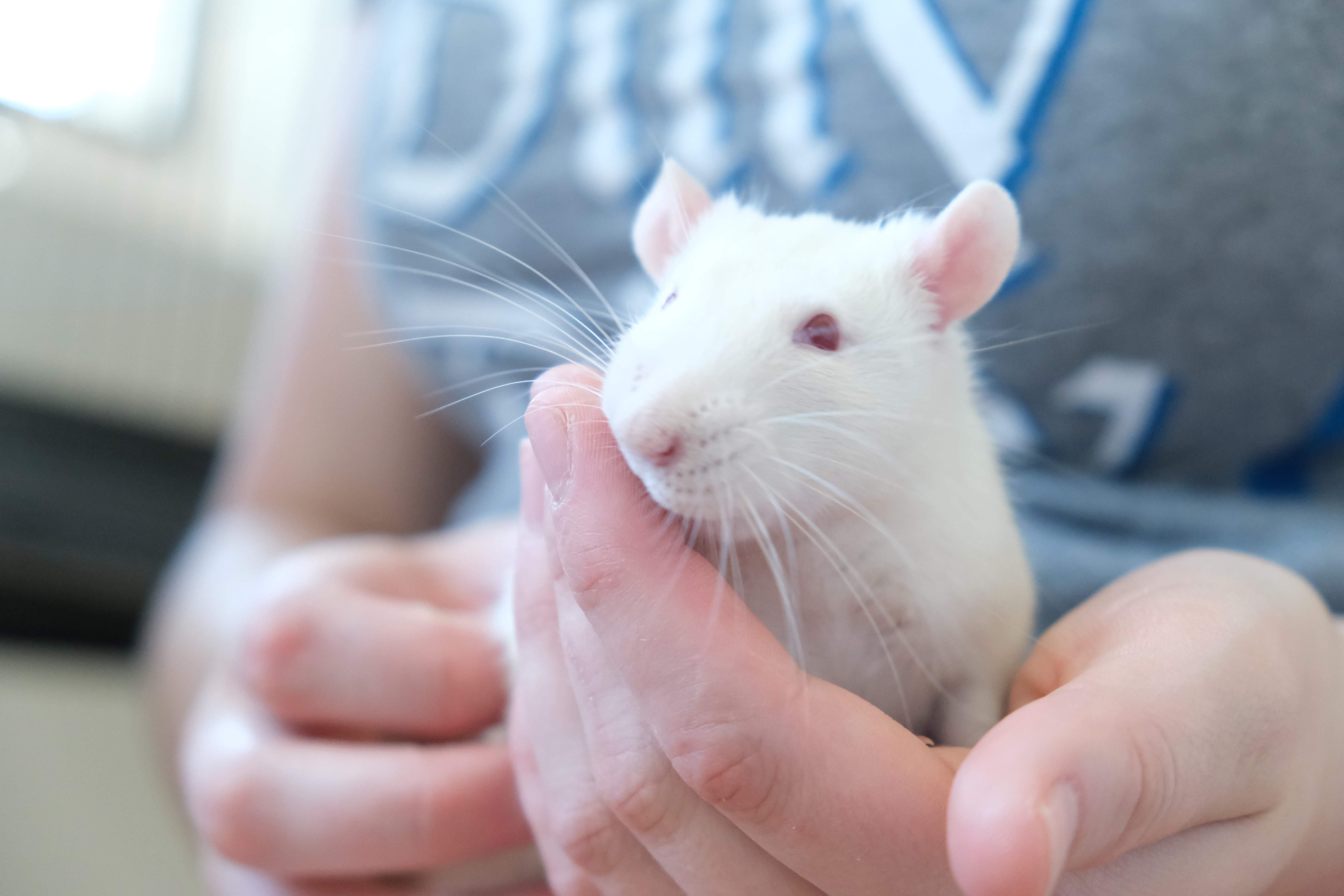
Care and behaviour go hand-in-hand when it comes to understanding and providing the best quality-of-life for pet rats. While it may seem daunting at first, rat behaviour is actually quite easy to understand with ample examples. Providing adequate care will result in healthy behaviours being exhibted by your rats.
*Note: Sources and references are hyperlinked throughout the text and will take you to the original page or paper being referenced.*
The rat community is full of difficult to interpret, conflicting information. As a result of these discrepancies, there are several well-known ideas that have caused misunderstanding for rat owners and professionals alike. It is important to ensure that these are cleared to alleviate misunderstanding, preventing unnecessary stress for owners and their rats. Common myths are listed below, with a detailed debunking within the tab.
This statement is often heard alongside seemingly harmless photos and videos of rats interacting with other animals, such as dogs, cats, and birds. This is known as interspecies interaction. Despite this being a widespread phenomenon across the internet, it is NOT safe. Interspecies interaction is incredibly risky for all parties involved, and does not benefit your rats in any way.
Reasons why interspecies interaction is dangerous
Many places will recommend paper bedding over traditional wood beddings such as pine and aspen, fear mongering how they are dangerous due to the fact that they contain what is known as a “volatile organic compound” (VOC). While VOCs are harmful compounds, the kiln-drying process gets rid of these volatiles, rendering the bedding dry and safe. All farm and pet-grade softwood bedding will be kiln-dried in advance to remove moisture and potential pests.
Despite the advertisement of paper beddings being “dust-free,” paper bedding is also full of fine particles, which can inflame the respiratory system of rats. On top of this, paper lacks proper ammonia control. It has been found that paper bedding (CareFRESH Ultra) holds a significantly higher concentration of ammonia, accounting for nearly four times that of pine. Ammonia concentration in people is limited to 25ppm exposure per day under OSHA and UKHSE. In a rat cage, a rat will be much more closely exposed to ammonia, even at lower concentrations, than that of us in the same room due to the close contact with bedding and soiled hammocks.
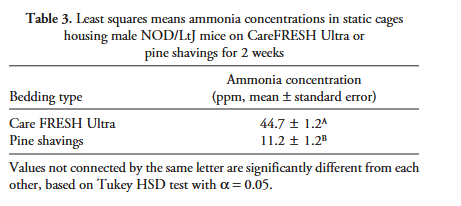
Ammonia is the biggest contributor to respiratory irritation and subsequent inflammation in rats, as it destroys the cilia present within the lungs. Cilia are small, finger-like projections in the respiratory tract of all mammals, and work alongside mucous to push out dust, dirt, and harmful pathogens. When cilia are destroyed, pathogens will increase in number within the respiratory tract, resulting in severe respiratory illness in rats.
In modern laboratory facilities, softwood bedding is the preferred and recommended choice in rodent cages due to the reduced dust and excellent ammonia control it provides. This is used as the standard in both the United States and Europe, as outlined in the Guide for the Care and Use of Laboratory Animals.
Additionally, the paper bedding that is available for laboratory use is higher grade than that of the bedding available for pet grade, due to the requirements for continuity and safety in the lab. Paper bedding found in laboratories is significantly less dusty, and designed overall for use in different circumstances. In pet-grade bedding, many
formulations also have unnecessary added dyes, perfumes, and baking soda
added to mask the odour control it lacks.
If you are still uneasy about using wood bedding or you have allergies to softwoods, hemp or horse-grade cardboard are great alternatives.
For a more in-depth explanation complete with studies, please check out my writeup below:
Rats naturally have high protein levels in their urine. When rat urine comes in contact with human skin, the high concentration of protein can alert the immune system to a perceived “threat”, resulting in an overreaction to the urine. This typically creates small, raised bumps (hives). Rat saliva also contains these proteins, which can also lead to reactions. Hives from rat urine and saliva typically subsides over the course of an hour, and are more of an itchy nuisance than a serious problem.
In fact, allergies to rodent saliva and urine are well documented. Nearly one in three people who are most commonly in contact with rodents have been found to develop allergy symptoms related to the exposure of rat urine. Reducing allergen exposure, washing your hands and arms after handling rats, and taking over the counter allergy medication can help.
The Ohio State University College of Veterinary Medicine has published an exceptionally helpful guide on rodent and rabbit allergies, as well as living with them. The only time you should be seriously concerned about a rat allergy is if it produces severe anaphylaxis symptoms.
Breeding rats is a very expensive, time-intensive endeavour. It requires a well-trained individual under the guidance of a mentor and many years of preparation. Ethical breeders will have adequate facilities, access to quality veterinary care, and are capable of covering the financial costs of operations through other sources of income.Most breeders do not turn a profit for the rats they sell to the public. Most, in fact, operate on a net loss, as it is exceptionally expensive to run a rattery.
Alfalfa and similar grass products are not digested by rats and serve as empty fillers to the diet. Timothy hay, though digestible, is not nutritionally beneficial either. Alfalfa has been shown to decrease growth rates in young rats.
For a more in-depth overview about proper diet, as well as safe and dangerous foods for rats, please view this excellent source produced by Silver's Rattery:
No properly bred rat should ever bite. While rats may nibble to groom, they should never draw blood. Keeping a biting rat poses serious risks to yourself and to their cagemates. Countless scientific studies spanning decades have shown that any sort of rat aggression is genetic in nature. It has been found that multiple specific genes, such as the Gltscr2, Lgi4, Zfp40, and Slc17a7 are contributors to the varying degrees of aggressiveness in rats. Specific regions of rodent DNA, known as quantitative trait loci, that correlate with tameness have also been identified.
This means that biting is not learned or trained behaviour, but comes from the way their bodies produce chemicals in response to how their genes are expressed in stressful situations. Less aggressive, more tame rats have multiple differences in their endocrine and adrenal systems, including lower serotonin levels, reinforcing the biological basis of rodent aggression.
Some rat owners may be willing to put up with occasional nipping when scared - until that rat bites you in an artery or causes severe nerve damage. I have lost the feeling in two of my fingers as a result of rat bites over the years, and have nearly broken finger bones from being bit. Aggressive rats can also unexpectedly bite cagemates because the cagemate doesn't know how to avoid scaring it as well as you might. Attacks from other rats can become fatal quickly if intervention is not sought.
In addition, a rat that chronically bites is regularly stressed, afraid, and unhappy; this is not a good quality of life for the rat. Since aggression is on a genetic basis, it cannot be trained out. There are no reliable studies that prove that rats can be successfully trained out of aggressive behaviour. There are significant risks owning aggressive rats and it is important to understand before taking on a potentially aggressive rat.
Proper pain medication dosing will PREVENT a rat from chewing and opening their surgical incisions.
Optimal doses should be dependent on weight. If a rat is messing with their surgical site, they are uncomfortable and likely in pain. Ensure that your veterinarian has prescribed enough pain medication to last at least twice a day for five days post surgery.
Free roaming outside increases stress in rats due to their ability to smell scent trails left by predators (such as dogs and cats). Since rats have poor vision, they rely on a strong sense of smell and their whiskers for navigating the world around them. Being in a vast, unfamiliar place with an overwhelming amount of smells increases their stress and can result in them darting off if they become startled. If a rat runs away, it is highly unlikely you will be able to get them back. Outdoor environments can also increase the potential of being exposed to parasites, poison, and pathogens.
Having a window open on a cool, clear day while your rats are in their cage is an option to safely give them enrichment. Alternatively, growing rat-safe grass and herbs in a dig box inside can give them a safe way of replicating being outside from the comfort and safety of their home.
This is a common misconception. Rats, just like humans, are social animals and spend their time in extended family colonies in the wild. It has been found that rats prefer contact with other rats in a small cage over having a larger place to themselves. It is unethical to house rats alone and is minimised as much as possible in research settings, as it causes an increase in stress, producing dysfunctions in the nervous system.
The carrier method is often recommended for introductions of new rat(s) to a preexisting group, as it forces the rats to interact with one another. However, this is not as safe as it may seem. If a fight is to break out between rats, there needs to be ample space for them to separate from one another. Having space prevents the rats from backing one another into corners with no route of escape, leaving them no other choice but to defend themselves. This is exceptionally dangerous for not only the rats involved (which can be seriously injured through bites and scratches), but also yourself, as if a fight breaks out in a tiny carrier, the only way of separating them is for you to stick your hand in.
The safest way to conduct introductions is to place all of the rats in a neutral area such as a bathtub, and watch them closely for signs of aggression towards one another. A plastic ladle or spatula is recommended to have on hand so you can easily separate offenders from one another if a fight does break out, preventing injury to yourself and the other rats.
If there are no signs of aggression after about an hour of monitoring, placing them in a clean cage with no hides that allow a rat to be backed into a corner is your next step. Following this, if all is well, it is safe to add hides back to the cage as the rats settle in.
While fruits and vegetables are excellent sources of vitamins, minerals, and hydration for rats, they should be given in moderation due to their natural sugar content. Rats require a high fibre, low fat diet. Laboratory-grade lab blocks, such as Oxbow Adult Rat (NOT garden select), Burgess Rat, and Science Selective Rat Food are designed to provide complete nutrition, avoiding the need for mixes and supplemental feeding. A rat can happily live its entire life eating solely a laboratory-grade block, as all of its nutritional needs will be met.
This doesn’t mean that you can’t give your rats treats - in fact this is encouraged! Try and aim for low sugar vegetables such as dark, leafy greens like broccoli or kale, and fresh herbs like basil and coriander (cilantro).
The key here is moderation. Limit the portion sizing and frequency of fresh fruit and veg. To get a good idea of a portion size for a rat, try and imagine what an oreo cookie would look like in your hand versus a rat’s - ideally you want a rat-sized oreo for your rat, not a giant one!
For more information on safe and unsafe foods, please visit
While rats enjoy climbing and moving around, by nature they are fossorial, meaning that they are ground-dwelling and enjoy digging and burrowing. In the wild, rats will climb trees and other structures, but return to their burrows for resting. Domestic rats have been shown to construct burrows indistinguishable from their wild counterparts. Providing rats with ample space to burrow as well as climb helps mimic natural behaviours and gives them options for rest and play.
Rat behavior can seem daunting at first, but is rather easy to pick up the more that you experience. Below is a catalogue of common behaviors, reasons behind these, and what they mean for you and your rats.
Rats love to play fight with one another. They can also do this to determine and maintain social hierarchies, which can result in some squeaks of annoyance from the victim. Here are some of the ways rats may play with one another:
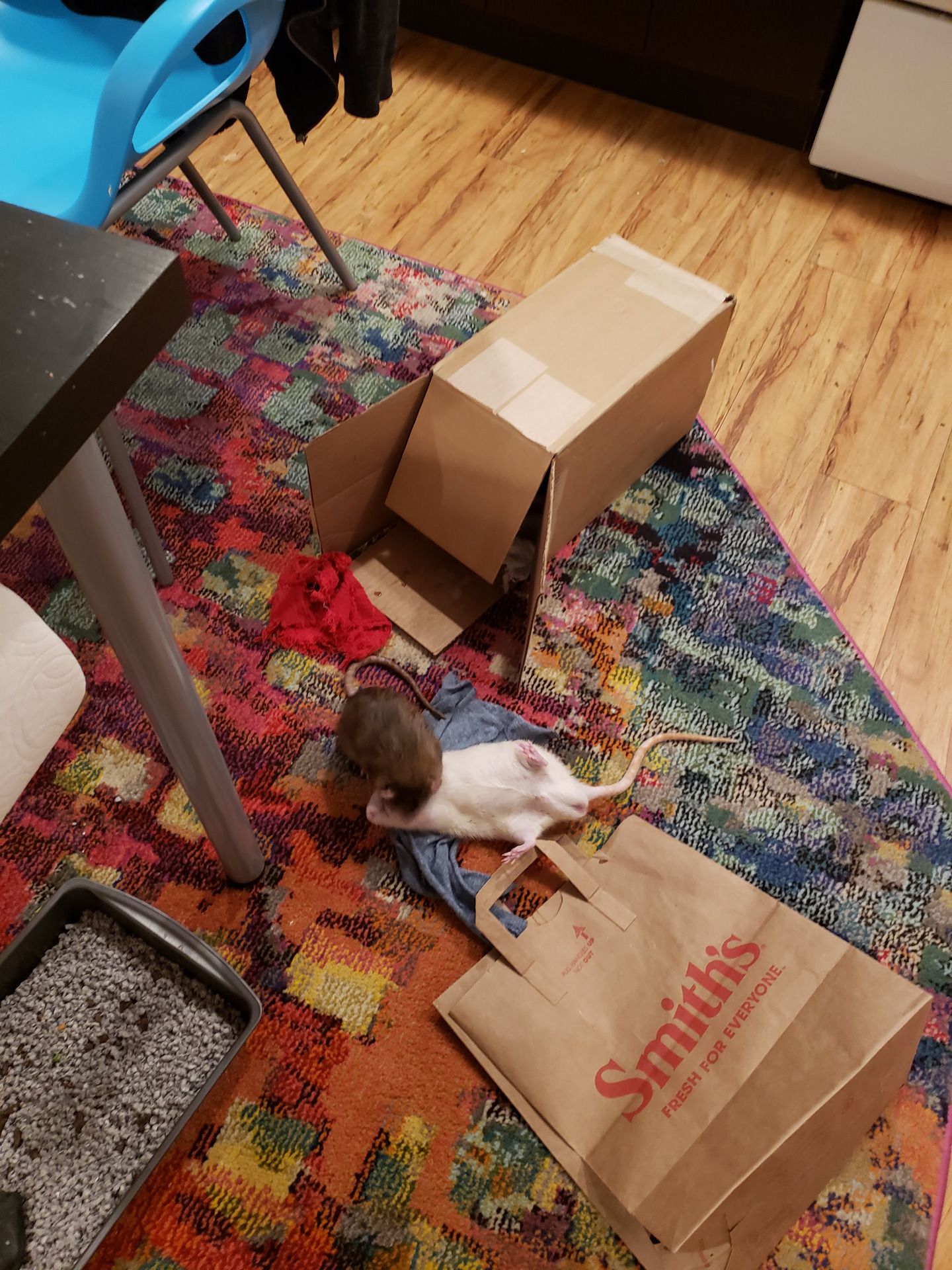
Futon pinning down Bento for a quick groom
Baby Playfight
Credit: @donkeyterrorist on Discord
When a real fight occurs, it is exceptionally explosive and frantic. A true fight is extremely dangerous, resulting in severe wounds and potential fatalities. With that in mind it is important to be able to be vigilant when introducing new rats to one another, and looking for signs of aggression that may lead to a fight if you do not intervene beforehand.
Signs of aggression may include:
Hissing (left) and Side-stepping (right)
Credit: @funkycanine on Discord
Popcorning is the term used to describe the behaviour in which a rat will unexpectedly jump or bounce around. Similar to how dogs get "zoomies" or how rabbits "binky", popcorning is associated with happiness and excitement. You will often see this happening in younger rats as they have more energy than their adult counterparts, but it is still pretty common to see.
Rats spend an enormous amount of time awake grooming themselves as well as their cagemates. They are fastidious cleaners, and much like a cat you will see them cleaning and scratching themselves throughout the day. Cleaning is also a form of social communication between rats, indicating hirearchy. Rats will oftentimes groom their owners as a sign of affection, since they consider us part of their social circle. This can involve licking, pushing fur apart, and gentle nibbling.
Baby Aang grooming himself at 2.5 weeks of age
While it may seem odd to us, it is quite normal for rats to sleep with their eyes open. During light sleep, known as their resting state, they are often found with their eyes open despite being asleep. It has been hypothesized that this is due to an adaptation rodents have acquired to increase survival: in the wild, a predator is much less likely to go for an animal who is appears "awake" than one that is asleep. It is more common for rats to sleep with their eyes opened at night than it is for them during the daytime.
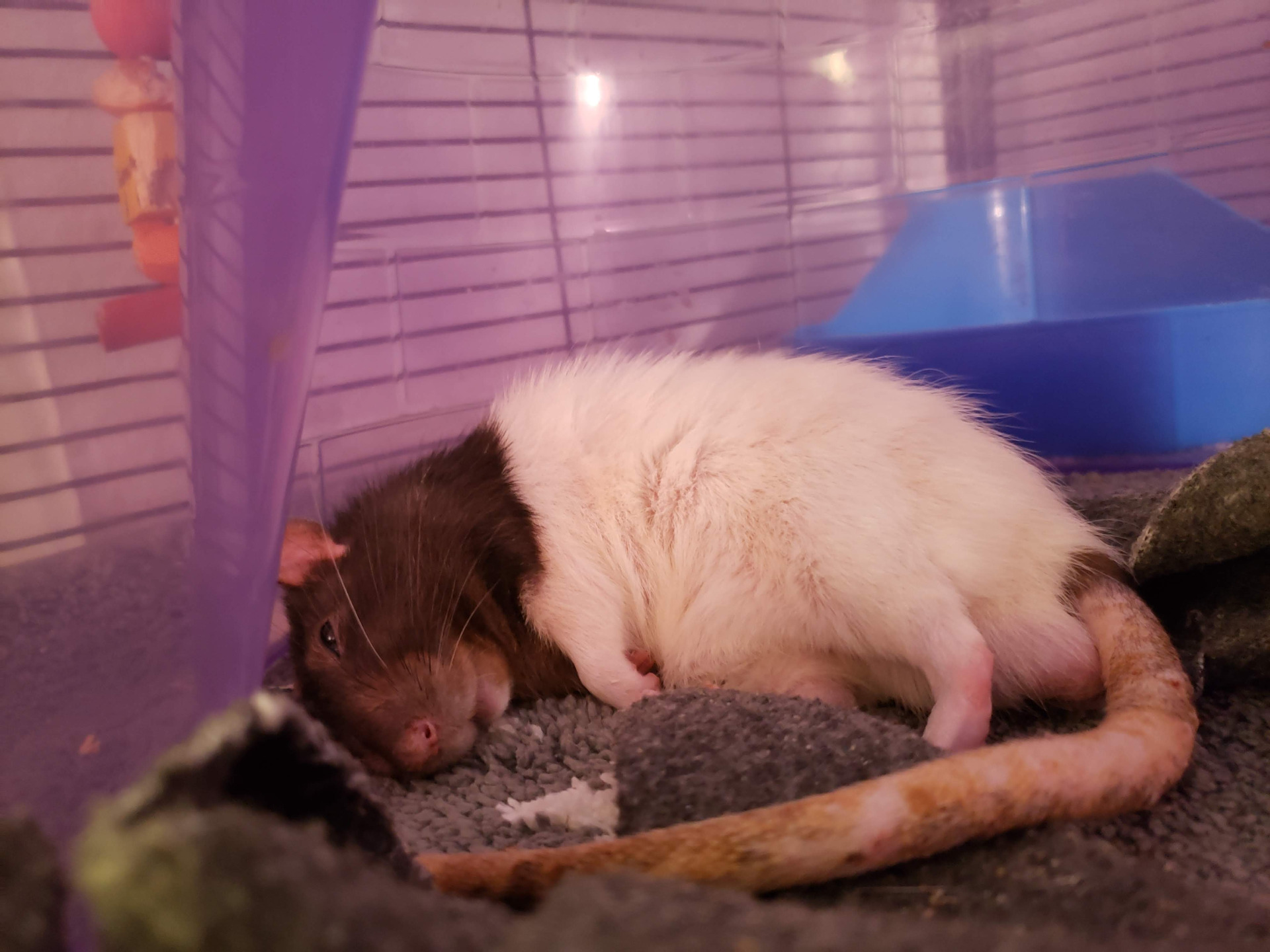
Taters having a nap with his eyes open
Rats demonstrate bruxxing and boggling as a way to express contentment and a state of relaxation. Bruxxing is the term to describe how a rat grinds their front teeth back and forth, creating a “crunching” sound. This is also how rats typically keep their teeth filed down naturally, as their teeth never stop growing. Boggling is the term to describe how, in response to bruxxing, rats’ eyeballs will vibrate rapidly, bulging out of the eye socket. They can also do this in times of stress as a coping mechanism, much like how cats will purr when stressed, and is an expression of extreme feeling.
An example of happy bruxxing and boggling
Even without vision problems like cataracts, rats are exceptionally blind. They cannot see well and rely on their whiskers and sense of smell for navigating the world around them. Even with this being the case, rats can still see some. In order to focus on an object further away from their field of scent/touch, rats will sometimes sway. This involves a small “scanning” motion with their head as they try to gain a better picture of what is going on. This behaviour is seen more commonly in pink or ruby-eyed rats, who have worse vision than standard black-eyed rats, but is not exclusive.
Baby Zabu swaying to try and focus on me
Rats often hiccup first thing after waking up. The rat will “jump” gently in place for a few minutes, and can be accompanied by a quiet “peep” sound (although hiccups are typically quiet). They quickly resolve after a few minutes and do not cause any discomfort to them.
Example of Hiccups, video credit to @avocadofries on Discord
Female rats have very short estrus cycles, and go into heat every 3-4 days. As a result, females will display sex-specific behaviours related to their hormonal levels, as this is how they indicate to a male that they are ready for mating. These behaviours are entirely normal and are really only silly to watch from a pet owner’s perspective.
Appa exhibiting the mating posture after being picked up while in heat
Credit: @antares_anta on Discord
Appa vibrating her ears in response to being touched
Credit: @antares_anta on Discord
Unlike humans, rats are unable to vomit. As a result, when a rat is choking it will appear that they are almost “gagging” without actually doing much of anything. Here is one of my rats, Frijoles, who happened to choke on a piece of cheese while I was filming him eating. He was fine after a few minutes:
A rat may push back their ears, open their mouths, and can sometimes even drool in response to whatever is stuck in the back of their throat.
Credit: eggisoup on Discord
Usually, choking resolves itself over a short course of time, as rats are pretty good at taking care of it on their own. There is no need to interfere, as this can sometimes make the situation worse by accident. However, in the event of an emergency it is essential that you take matters into your own hands to prevent your rat from dying.
Choking is only an emergency if you see signs of oxygen deprivation. Signs will include: loss of colour in the limbs, blue tongue, lack of motion or intense gasping attempts.
In the event of oxygen deprivation, take the rat between your hands and make sure you are supporting the neck and spine. The rat’s head will be between your fingers, with the rest of the body on the palm of your hand. Lift the rat above your head with your arms straight. Spread your legs and sharply swing the rat between your legs. Repeat this a few times until the blockage becomes unstuck and bring your rat to a veterinary professional as soon as possible.

For a more in-depth look at the signs and symptoms of common health problems, please visit the Medical Library Page.

The Rat Grimace Scale, by the National Centre for the 3Rs in Research
The grimace scale is a handy guide used in research and veterinary practices alike to provide a means of assessing discomfort in rats. Created by the National Centre for the Replacement, Refinement, and Reduction of Animals in Research (NC3Rs), this guide is backed by research that demonstrates how changes in facial expressions correlate to pain. Since rats are prey animals, they typically hide pain well and only show minimal signs until they are severely unwell. Understanding rat body language can help aid in catching illnesses and injuries well before they become veterinary emergencies.
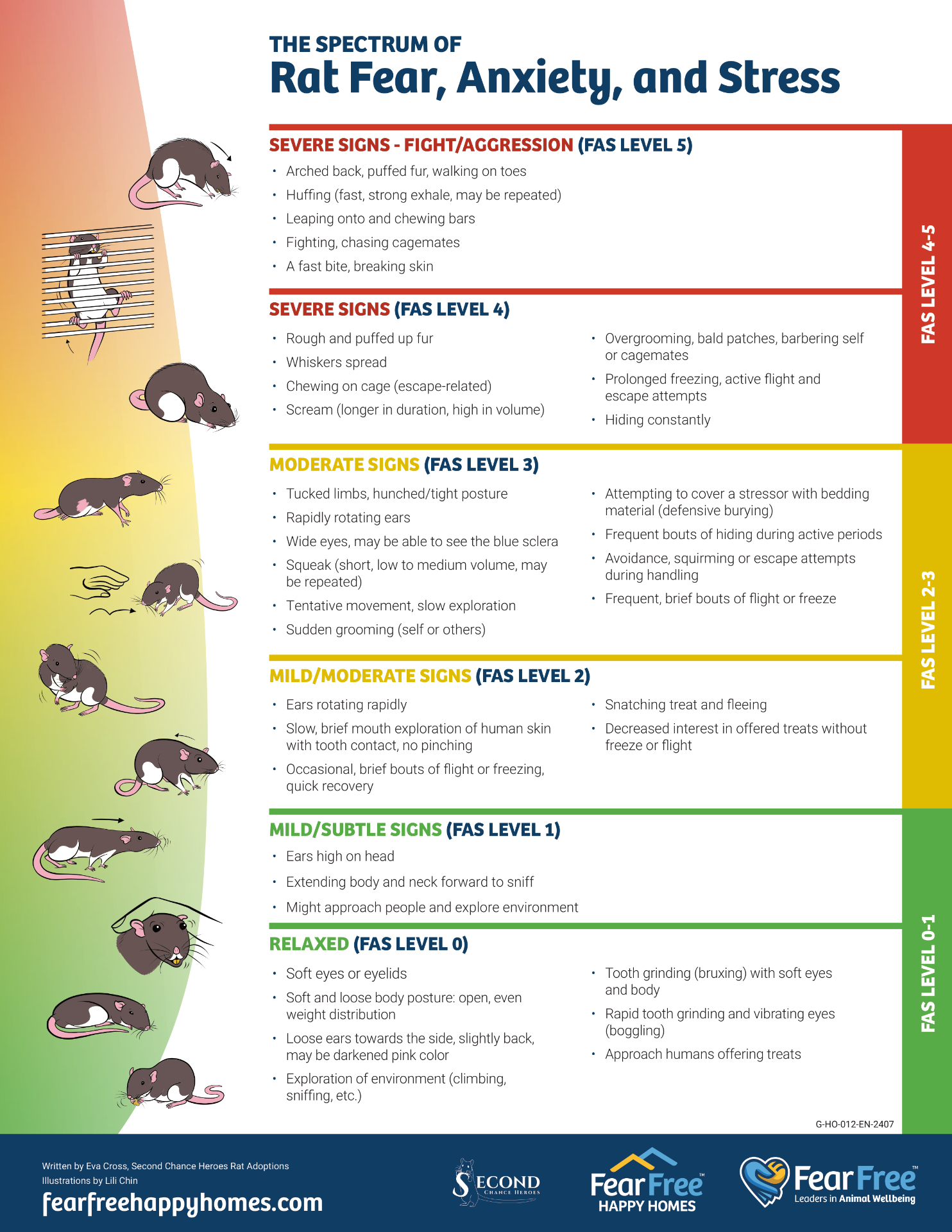
Alongside showing pain and discomfort signs, rats will often show a spectrum of anxiety and stress. FearFree has developed a helpful guide in deciphering the spectrum of Fear, Anxiety, and Stress (FAS).
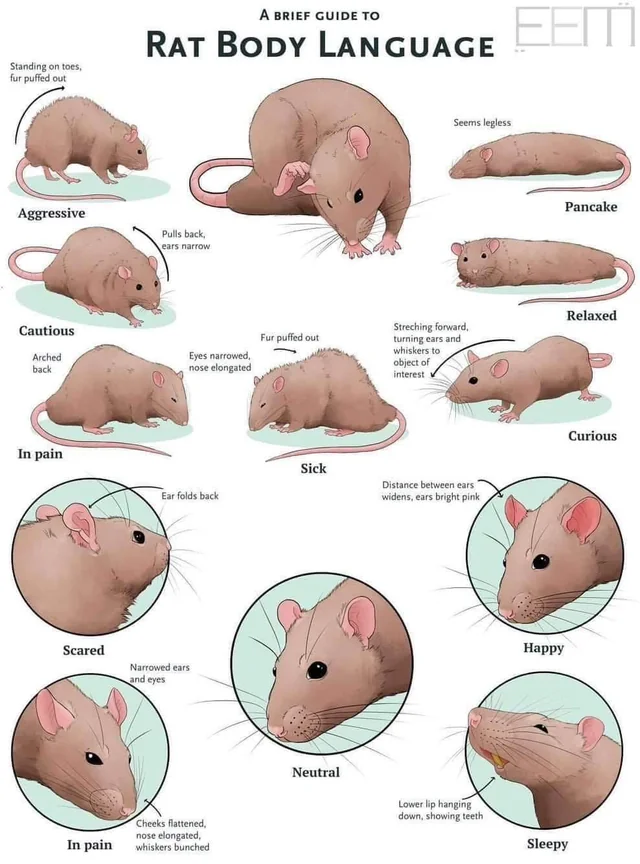
A Brief Guide to Rat Body Language, by Maija Karala (@maijakarala.bsky.social)
Alongside common behaviours, rats exhibit subtle body language that can provide us insight into how they are feeling. In fact, rats have been found to display a variety of different facial expressions in response to both positive and negative stimuli. Additionally, rats can even “blush” to indicate that they are happy and pleased.
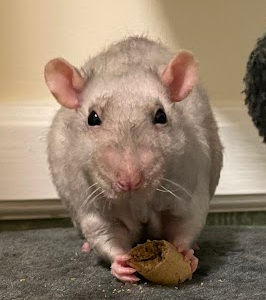
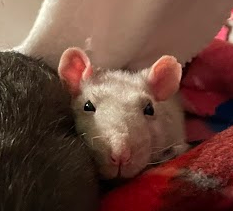
Archie alert (left) versus blushing (right)
Just like humans, rats come in a variety of shapes and sizes. Weight is exceptionally variable between rats, and 400 grams may be a completely healthy weight for one whereas 400g is dangerously underweight for another. The best way to determine if a rat is under, over, or at ideal weight is through the dangle test. To do this, you will be evaluating the front, with your rat’s abdomen facing you. For accurate results, scruffing is best, but if you are unable to get a good hold, you can place your thumb and forefinger under the shoulders and stretch the body out.
If the rat is at a good weight, sides will appear to go straight down, or have a slight definition. If the rat is underweight, sides will appear to curve inwards, and if the rat is overweight the sides will “bulge” outward.
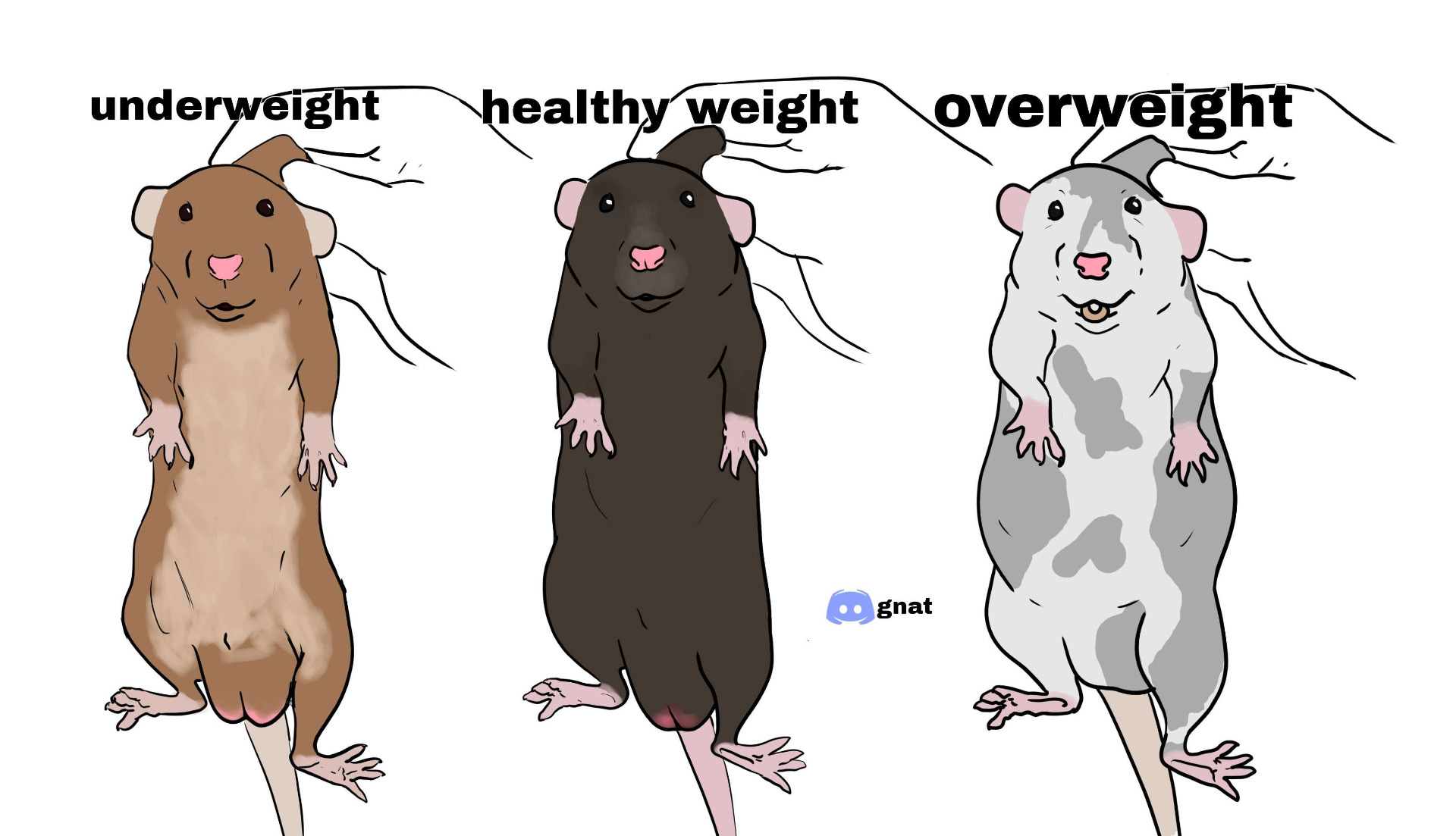
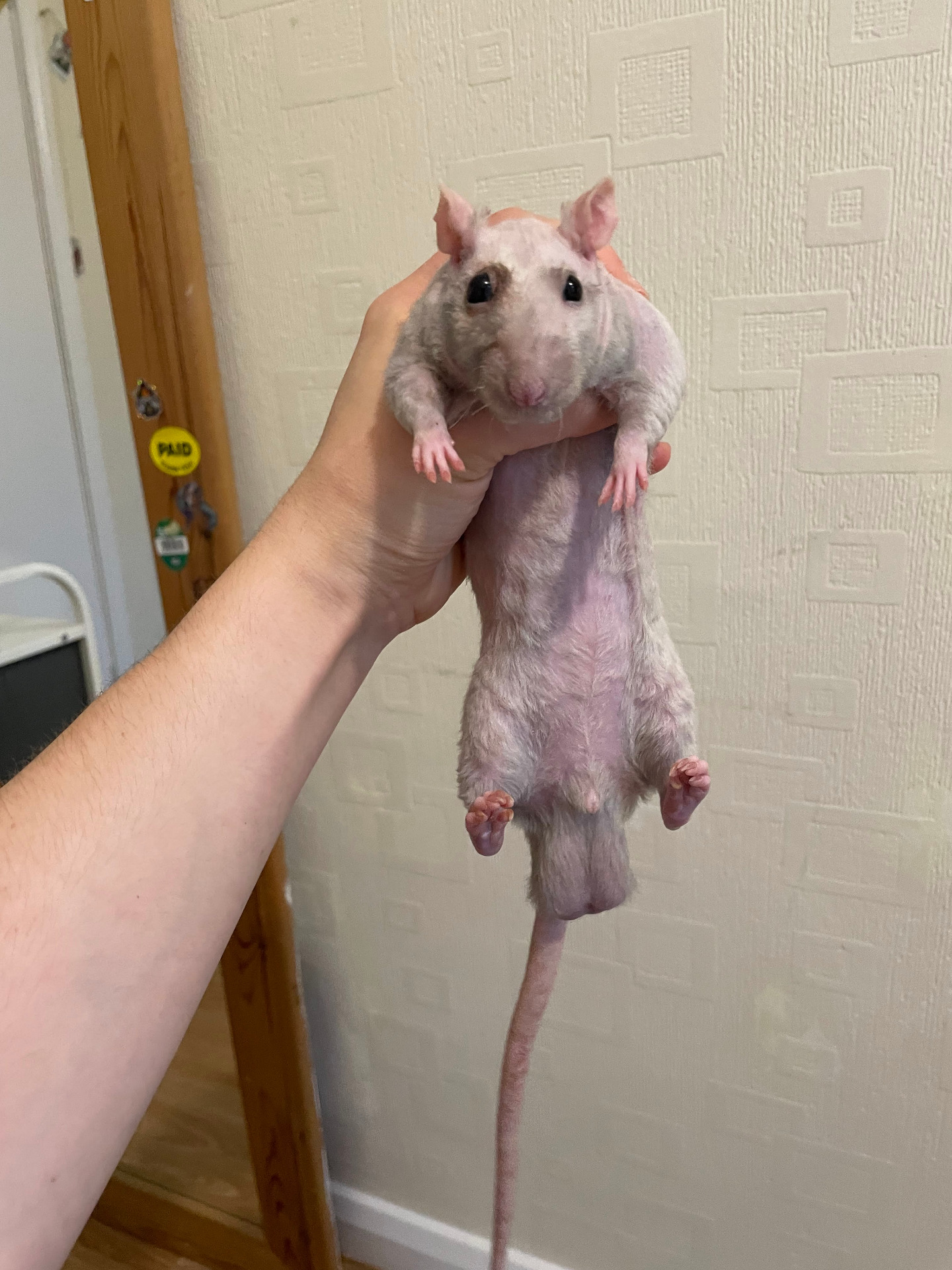
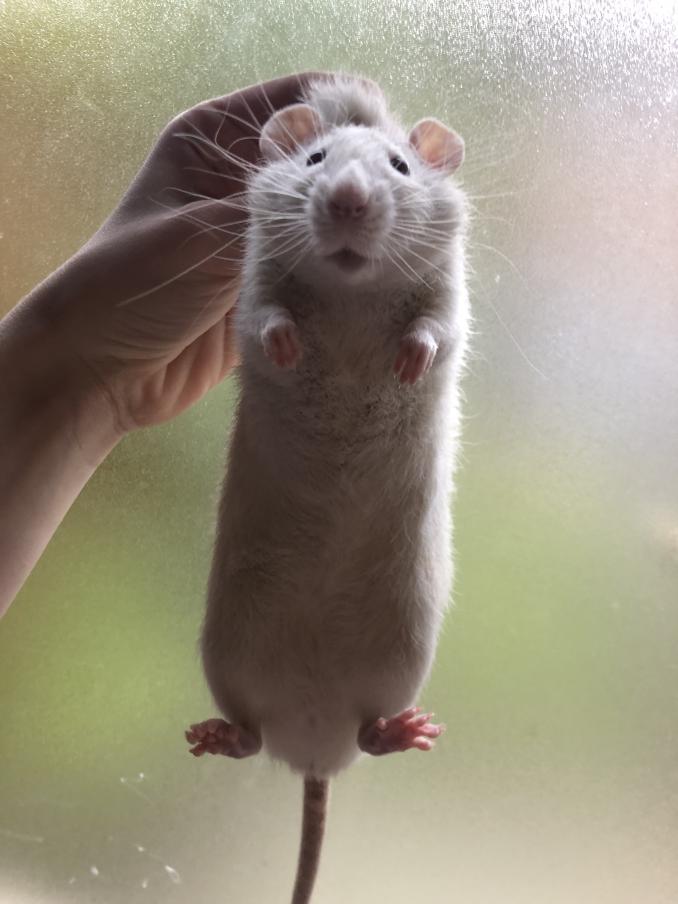
Archie (left) is an underweight rat versus Moomin (right) at an ideal weight (credit @th39o on Discord)
Respiratory illness is one of the most common ailments of pet rats and is often due to an opportunistic bacteria living in the lungs known as Mycoplasma pulmonis. When a rat becomes immunocompromised, a respiratory illness can arise. The starting signs are often difficult to catch, but most cases are comprised of a series of stages:
The sooner a rat is seen, the greater the chance of recovery. If a rat is past stage 2, there is poor prognosis, especially if it progresses to a more severe condition, such as pneumonia. It is for this reason that rats must be seen by a veterinarian as soon as possible. Respiratory illnesses can cause a rat to go downhill in as little as 12 hours from the start of symptoms and needs proper medical attention. If not treated, respiratory illnesses are fatal. They will not resolve on their own.
Mild Stage Respiratory Illness Signs - note the increased breathing labour, but minimal other signs present
Credit: @hanaverion on Discord
Mid Stage Respiratory Illness Signs - note the increased breathing labour, side sucking, and puffiness present. The hunched posture is also indicative of being uncomfortable/in pain
Credit: @potats on Discord
Late Stage Respiratory Illness Signs - note the severe, laboured breathing, side sucking, lethargy, and gasping. This rat needs to be seen by an emergency veterinarian immediately to be put on supplementary oxygen.
